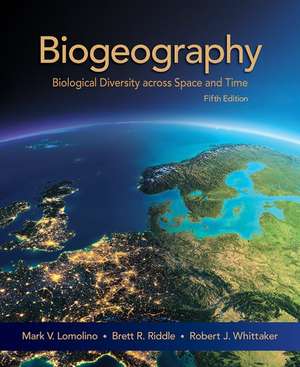Biogeography
Autor Mark V. Lomolino, Brett R. Riddle, Robert J. Whittakeren Limba Engleză Hardback – 31 oct 2016
and marine environments has influenced the fundamental processes of immigration, extinction, and evolution to shape species distributions and nearly all patterns of biological diversity. It is an empirically and conceptually rich text that illustrates general patterns and processes using examples
from a broad diversity of life forms, time periods and aquatic and terrestrial ecosystems. Biogeography, Fifth Edition, is written as a primary text for undergraduate and graduate courses, and is also an invaluable reference for biogeographers, ecologists, evolutionary biologists, and conservation biologists. Its fundamental assertion is that patterns in biological diversity make little
sense unless viewed within an explicit geographic context. Starting from principal patterns and fundamental principles, and assuming only a rudimentary knowledge of biology, geography, and Earth history, the text explains the relationships between geographic variation in biological diversity and the
geological, ecological, and evolutionary processes that have produced them. The use of color illustrations, evaluated and optimized for colorblind readers, has transformed our abilities to illustrate key concepts and empirical patterns in the geography of nature. By providing a description of the historical development of biogeography, evolution and ecology, along with a
comprehensive account of the principal patterns, fundamental principles and recent advances in each of these fields of science, our ultimate vision is for Biogeography to serve as the centerpiece of a one- or two-semester core course in biological diversity. Instructor's Resource Library
The Biogeography, Fifth Edition, Instructor's Resource Library includes all of the textbook's figures (both art and photographs) and tables in electronic format. All images are provided in both JPEG (high- and low-resolution versions) and ready-to-use PowerPoint presentations. The figures have all
been formatted and color-enhanced for optimal projection in the classroom.
Preț: 1373.91 lei
Preț vechi: 1745.00 lei
-21% Nou
262.98€ • 285.75$ • 221.05£
Carte disponibilă
Livrare economică 20-26 martie
Livrare express 14-20 martie pentru 300.18 lei
Specificații
ISBN-10: 1605354724
Pagini: 784
Dimensiuni: 284 x 234 x 33 mm
Greutate: 2.04 kg
Ediția:5
Editura: Oxford University Press
Colecția OUP USA
Locul publicării:New York, United States
Descriere
Biogeography, first published in 1983, is one of the most comprehensive text and general reference books in the natural sciences. The fifth edition builds on the strengths of previous editions to provide an insightful and integrative explanation of how geographic variation across terrestrial
and marine environments has influenced the fundamental processes of immigration, extinction, and evolution to shape species distributions and nearly all patterns of biological diversity. It is an empirically and conceptually rich text that illustrates general patterns and processes using examples
from a broad diversity of life forms, time periods and aquatic and terrestrial ecosystems.
Biogeography, Fifth Edition, is written as a primary text for undergraduate and graduate courses, and is also an invaluable reference for biogeographers, ecologists, evolutionary biologists, and conservation biologists. Its fundamental assertion is that patterns in biological diversity make little
sense unless viewed within an explicit geographic context. Starting from principal patterns and fundamental principles, and assuming only a rudimentary knowledge of biology, geography, and Earth history, the text explains the relationships between geographic variation in biological diversity and the
geological, ecological, and evolutionary processes that have produced them.
The use of color illustrations, evaluated and optimized for colorblind readers, has transformed our abilities to illustrate key concepts and empirical patterns in the geography of nature. By providing a description of the historical development of biogeography, evolution and ecology, along with a
comprehensive account of the principal patterns, fundamental principles and recent advances in each of these fields of science, our ultimate vision is for Biogeography to serve as the centerpiece of a one- or two-semester core course in biological diversity.
Instructor's Resource Library
The Biogeography, Fifth Edition, Instructor's Resource Library includes all of the textbook's figures (both art and photographs) and tables in electronic format. All images are provided in both JPEG (high- and low-resolution versions) and ready-to-use PowerPoint presentations. The figures have all
been formatted and color-enhanced for optimal projection in the classroom.
Notă biografică
Mark V. Lomolino is a Professor in the Department of Environmental and Forest Biology at the SUNY College of Environmental Science and Forestry. His research and teaching focus on biogeography, community ecology, and conservation of biological diversity. He is a cofounder and past President of the International Biogeography Society. Dr. Lomolino received the American Society of Mammalogists Award for his dissertation studies on the ecology,evolution, and biogeography of insular mammals.Brett R. Riddle is a Professor in the School of Life Sciences at the University of Nevada, Las Vegas. His research focuses primarily on the history of biodiversity in western North America, with ongoing projects including: historical assembly of the warm desert biotas; phylogeography of Great Basin cold desert and montane island biotas; and molecular systematics and biogeography of a diverse cadre of North American rodent groups. He is a cofounder and past President of theInternational Biogeography Society.Robert J. Whittaker is Professor of Biogeography in the School of Geography and the Environment at the University of Oxford and holds a part time Professorial position at the Centre for Macroecology, Evolution and Climate in the University of Copenhagen. He is a cofounder and past President of the International Biogeography Society. He is coauthor of Island Biogeography: Ecology, Evolution, and Conservation (OUP, 2007). His research interests span island biogeography,diversity theory, macroecology, and conservation biogeography.
